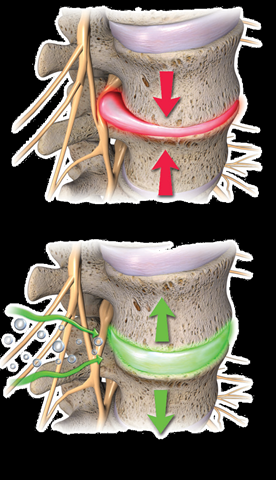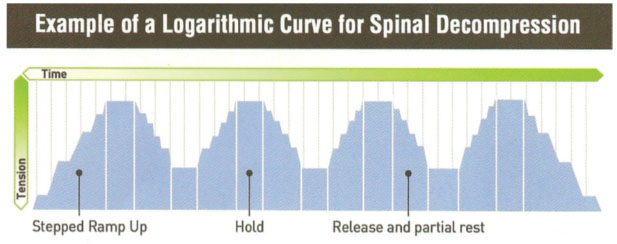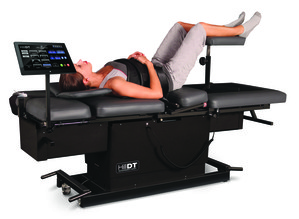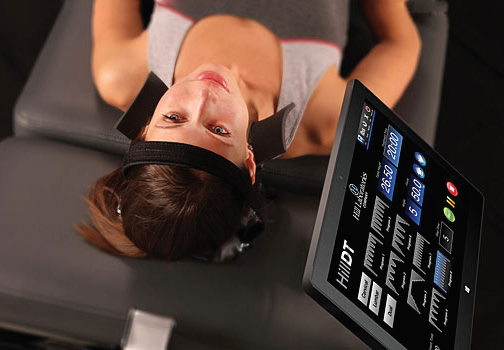
Do you suffer from chronic neck or low back pain?
The pain may come from compressed spinal discs, joints, nerves, or spinal arthritis.
The top image illustrates a bulging disc with a pinched nerve. The bottom image illustrates a
healthy decompressed disc and nerve. Now there is hope for lasting relief for neck and back pain due to compressed discs, joints and nerves. This new and gentle ‘Non Surgical Spinal Decompression’ technique may be able to help your pain if it is caused by:
•Bulging/Herniated Discs
•Degenerative Joint and Disc Disease
•Stubborn Muscle Spasms / Adhesions
•Facet Syndrome
•Failed Back Surgery
•Spinal Stenosis
How does spinal decompression work?
A slow series of pulls, holds and releases creates negative pressure within the discs. Overtime, this vacuum effect may, in many cases, help the bulging disc material to be ‘drawn back into place’. The fibres in the outer ring of the disc are also helped to heal by the increased nutrient circulation caused by the gentle pumping movement created in the disc and facet joints.
How is Spinal Decompression different from traction?
Regular t raction does not provide the special logarithmic movement, systematically increasing and decreasing the decompression, the way the HillDT table does. This decompression cycle is a critical part of the success of this therapy, as it creates a vacuum and draws the essential oxygen and nutrients into the discs and flushes metabolites out, which helps healing. Below is an example of one of the 8 programs that our HillDT table has. This computerized program is unique to the HillDT and is one of the things that separates it from standard traction.

How long does it take and how much does it cost.
Generall y it takes 8-12 weeks for a disc to heal with decompression therapy.
Usually 20-30 treatments over 2-3 months is required to achieve the best result possible. Ideally we start with 3 treatments per week then dropping to 2 treatments per week as you improve. The cost per session is the same as a standard chiropractic consultation.
What success rate does this treatment have?
Appro ximatel y a 90% success is achieved with spinal decompression providing patients are candidates for decompression and they follow through with their treatment plan in full. Results, however, can never be promised, and you still may require surgery. We will monitor your progress and will refer you to your doctor if we are not happy with your progress.
Will I feel immediately better?
Som e people feel a change after one to two sessions. Others feel a change after 5-8 sessions. Still others do not feel a change until 20 to 25 sessions. It all depends on how much inflammation you have, how long you have had your problem, how severe the problem is and how well you follow our guidelines regarding sleep, nutrition, supplements and activities. Every case is different and we can give no guarantees regarding how long it will take to get better.
Do you want to know if your case is suitable for decompression?
Book a ‘Decompression Assessment’ where we will review your case. The assessment includes a full neurological and orthopedic examination and the study your x-rays/MRI/CT scans to determine if you are a candidate of decompression therapy and to determine the exact program and script for your treatment. If we feel that we can help you we will be arrange acomplimentary first session on our decompression table. If w e feel w e can’t help you with decompression we will suggest other pathways of care to relieve your condition.
Bookings are essential for a complimentary first session on our decompression table .
Call 07 3823 2282 to speak to our friendly receptionist today.
What does the treatment look like?
Below is an example of a lumbar spine decompression therapy session. The pelvis is angled differently depending on which exact disc level is being targeted. The computer has seven
sensors that constantly measure the amount and exact timing of each stage of decompression.

Below is an example of a cervical spine decompression therapy session.
The head and neck is angled differently depending on which exact disc level is being targeted. Notice, there is no strap pulling on the jaw so it will not cause or aggravate TMJ pain.

What does it feel like?
Apart from the initial pulling sensation, which you quickly get used to, it is very relaxing. In fact, many people fall asleep. Even if you do not feel much of astretch your discs are still being pumped, your joints are being opened, and nutrients are being drawn into the discs and joints. We start with a low setting of pull, to ensure your safety and comfort. Once you can cope with this, we steadily increase the settings with each visit.
Due to stretching of scar tissue some people may have a flare up of their pain during or after treatment. This is normal, temporary, and should pass within a few days. In the acute stage we recommend applying ice, rather than heat, repeatedly at a rate of 10 minutes on and 10 minutes off to an area that has been treated, to reduce inflammation. As the inflammation subsides, after 36 hours, you can alternate between heat and ice. After a week you can apply heat for 20 minutes twice a day.
During your care we expect any arm or leg pain to recede or centralise to your neck or back. If you have leg pain or pins and needles you may experience a temporary increase in back pain as the arm or leg symptoms disappear. This is also normal, and temporary @ and a good sign that you are getting better.
We do regular reassessments of your condition so that we can adjust your care as needed with
the aim of you getting the maximum results as soon as possible. We expect to see: a decrease in pins and needles if you have any; a decrease in numbness; a return of normal sensation, an increase in function and an increase in your range of motion.
What does each treatment involve?
Once your spinal level and treatment type has been prescribed you will receive progressive gradual adjustments to your decompression program as we make progress with your spine. With each session your exact requirements will be entered into the computer, you will be
comfortably strapped in, and the program will start. You stay fully clothed and you will be left
in peace to relax for 20 minutes while your spine decompresses in exactly the way you need it to.
After your treatment
We advise that you go for a 10 minute walk to maintain the mobility. Prolonged sitting and stooping activities should be avoided as they are known to increase lumbar discs compression. Minimise looking down at your computer screen or phone to prevent forward head posture neck strain.
Does decompression replace traditional chiropractic care?
Spinal decompression is often used as a stand alone treatment. It is frequently prescribed by spinal surgeons and medical doctors as an option to prevent the need for spinal surgery. It is particularly worth trying if the patient is contemplating spinal surgery or if they are afraid of spinal manipulation.
In some cases, however, if your spine needs a manual adjustment and does not get it, you will not get the full benefits of decompression therapy. Therefore, we advise spinal decompression to be used in conjunction with your regular chiropractic care. If you need both chiropractic and decompression appointments on the same day, we recommend that you have the decompression first, followed by a chiropractic adjustment.
Even if you have not received results from previous chiropractic, physiotherapy or acupuncture treatments spinal decompression is worth trying . You may find this new type of treatment will be able to help. It may show you a new way forward especially with specific disc and arthritis issues. If you have any questions, consult your chiropractor.



